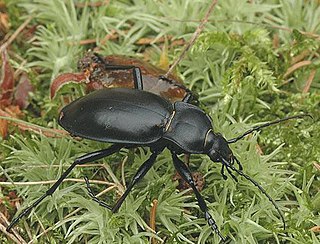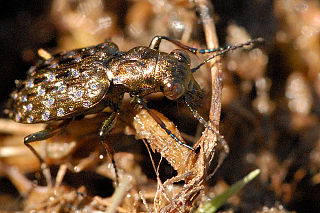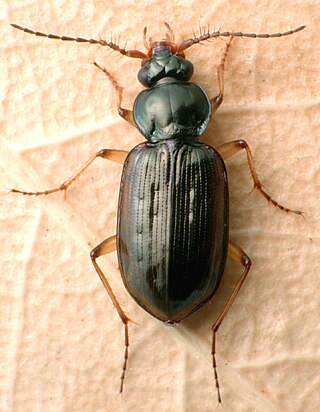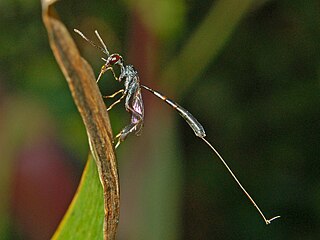
Nikolay Nikolayevich Semyonov, was a Soviet physicist and chemist. Semyonov was awarded the 1956 Nobel Prize in Chemistry for his work on the mechanism of chemical transformation.

Andrey Petrovich Semyonov-Tyan-Shansky was a Russian entomologist specializing in beetles. He was the son of Pyotr Semyonov-Tyan-Shansky.

Carabus is a genus of beetles in family Carabidae. The genus is highly diverse with 94 subgenera, 959 species and 2300 subspecies, thus is the largest genus in the subfamily Carabinae. The vast majority are native to the Palearctic, but 16 Nearctic species are also known. Carabus spp. are 12–50 mm (0.47–1.97 in) long, and most species are wingless and often very colourful. These are nocturnal, predatory beetles that feed on snails, earthworms, and caterpillars. Most Carabus species were thought to have inhabited the Eurasian forest, but the species' low dispersal abilities altered the distribution of lineages within the genus.

Elaphrus is a genus of ground beetle native to the Palearctic, the Nearctic, the Near East and Northern Africa. It contains the following species:

Elaphrus riparius is a species of ground beetle native to the Palearctic and the Near East. In Europe, it is found in Austria, Belarus, Belgium, Great Britain including Shetland, Orkney, Hebrides and Isle of Man, Bulgaria, Croatia, the Czech Republic, mainland Denmark, Estonia, Finland, mainland France, Germany, Hungary, Republic of Ireland, mainland Italy (doubtful), Kaliningrad, Latvia, Liechtenstein, Lithuania, Luxembourg, Northern Ireland, mainland Norway, Poland, Russia, Slovakia, Slovenia, mainland Spain, Sweden, Switzerland, the Netherlands, Ukraine and Yugoslavia.

Loricera is a genus of ground beetles in the family Carabidae, the sole genus of the subfamily Loricerinae. There are about 17 described species in Loricera.

Broscus is a genus of ground beetle native to the Palearctic, the Nearctic, the Near East and North Africa. It contains the following species:

Discoptera is a genus of beetles in the family Carabidae, containing the following species:

Licininae is a subfamily of beetles in the family Carabidae, containing the following genera:
Colpostoma is a genus of beetles in the family Carabidae, containing the following species:

Platyninae is a subfamily of ground beetles.
Acalathus is a genus of ground beetles in the family Carabidae. There are about 13 described species in Acalathus, found in China.
Stenolepta is a genus of ground beetles in the family Carabidae. There are at least three described species in Stenolepta.
Synuchus pseudomorphus is a species of ground beetle in the subfamily Harpalinae. It was described by Semenov in 1889.
Elaphrus hypocrita is a species of ground beetle in the subfamily Elaphrinae. It was described by Semenov in 1926.
Elaphrus potanini is a species of ground beetle in the subfamily Elaphrinae. It was described by Semenov in 1889.
Elaphrus tibetanus is a species of ground beetle in the subfamily Elaphrinae. It was described by Semenov in 1904.
Elaphrus trossulus is a species of ground beetle in the subfamily Elaphrinae. It was described by Semenov in 1904.
Apatophysis is a genus of longhorn beetles in the subfamily Dorcasominae.

Gasteruption is a genus of wasps belonging to the family Gasteruptiidae subfamily Gasteruptiinae.









